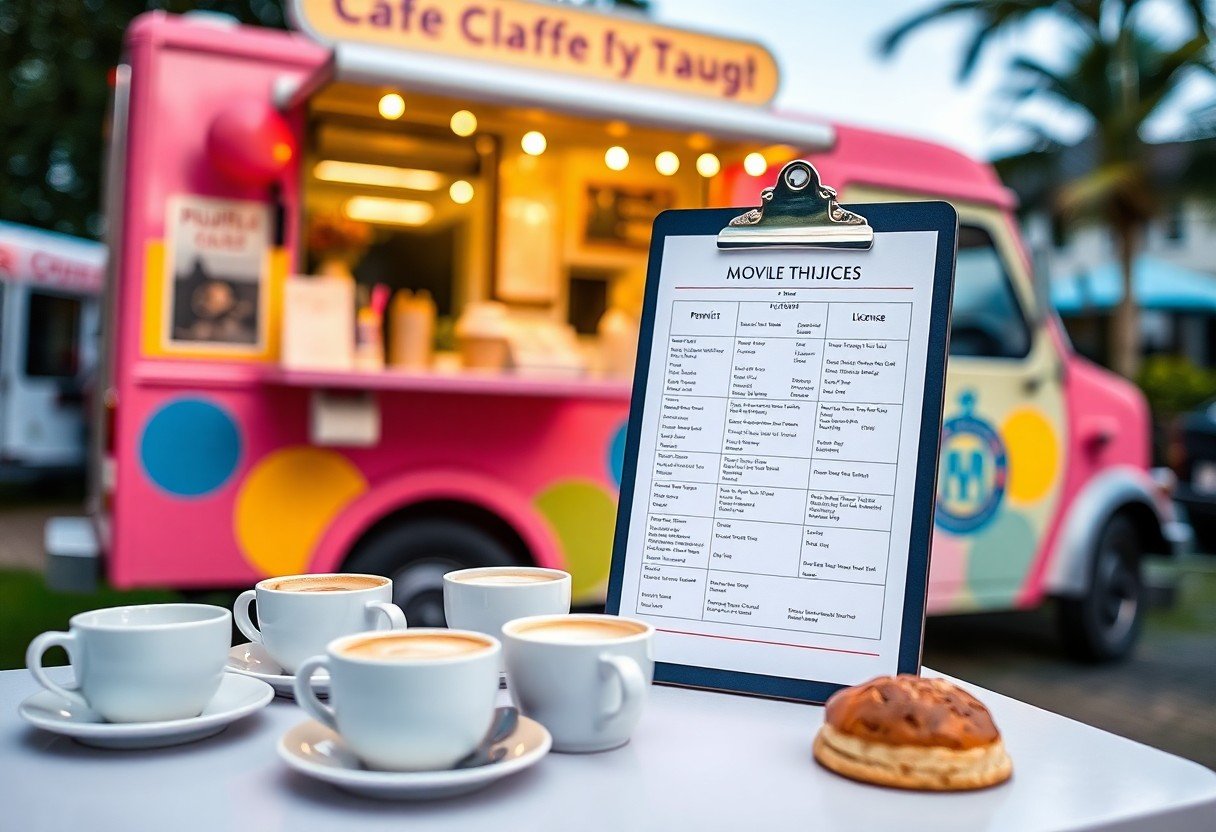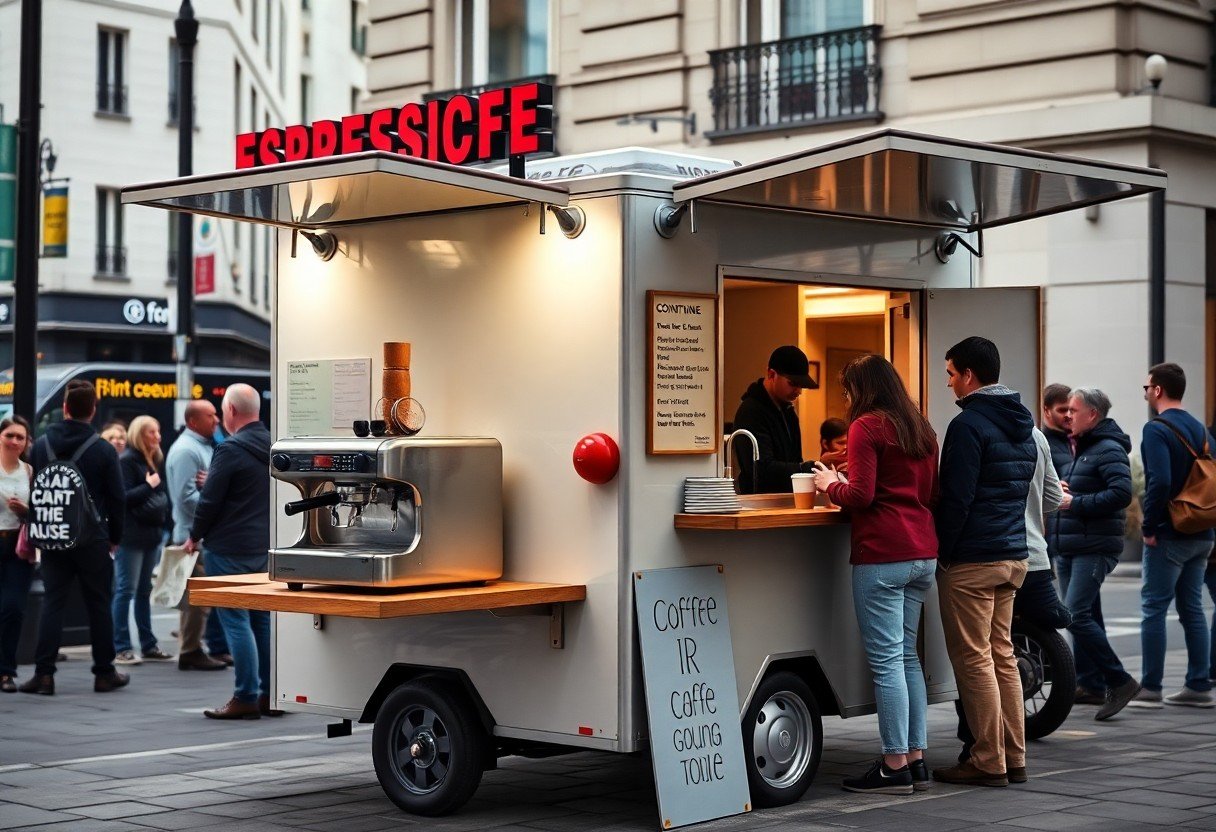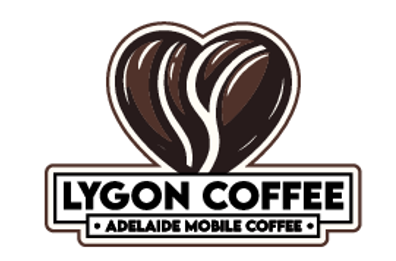Igniting Your Passion: The Vision Behind Your Mobile Cafe
Finding Your Niche
Your mobile cafe’s vision begins with identifying a niche that resonates with your passion. Consider what excites you about beverages and food—do you have a penchant for specialty coffee, artisanal teas, or perhaps gourmet sandwiches? Researching trending concepts, such as vegan options or unique flavor profiles, can help you carve out a space in the competitive market. An inspiring example is a mobile cafe in Portland that specializes in organic, locally sourced ingredients, significantly attracting health-conscious customers while maintaining a strong community presence. By pinpointing your niche, you lay the groundwork for a brand that reflects your unique style and vision.
Crafting a Brand Story
Your brand story will connect emotionally with potential customers. Outline your journey and motivations—what led you to create this mobile cafe? Share anecdotes about experiences that shaped your vision, such as memorable encounters with coffee farmers or the community events that inspired your menu. Transparency is key; consumers often choose brands that share their values, and a heartfelt story can foster loyalty and trust. Implementing elements of your personal journey into branding ensures your cafe stands out, just as a Richmond-based mobile coffee unit did by highlighting its founder’s adventure through various coffee cultures around the world.

Crafting Your Business Blueprint: Essential Planning Steps
Defining Your Unique Concept
Your mobile cafe concept should resonate with both your personal style and the preferences of your target audience. Think about the type of cuisine you want to serve, whether it’s artisanal coffee, gourmet sandwiches, or exotic smoothies. Research existing mobile cafes in your area to identify gaps in the market. For instance, a thematic approach, like a vintage-style cafe or a health-focused juice bar, can attract a niche clientele and set you apart from competitors. Visualize your brand, from the look of your truck to the presentation of your menu items. This cohesiveness plays a significant role in creating a memorable experience for customers.
Consider also the element of service. Offering a unique experience, such as barista interaction or customization options for beverages, can enhance customer engagement. Additionally, think about integrating local ingredients into your menu, which can appeal to consumers’ growing desire for sustainability and community support. Your unique concept should reflect not only what you love but also what excites potential customers, ensuring a strong foundational identity for your cafe.
Identifying Your Target Market
Understanding your target market is vital for the success of your mobile cafe. Start by conducting surveys or informal interviews to gather data on potential customers’ preferences, habits, and spending patterns. Are you aiming to serve busy professionals in office parks, families at community events, or health-conscious individuals at local farmers’ markets? Each segment requires a different marketing approach and service style. For example, a family-oriented cafe may benefit from a playful menu, while a professional-targeted service might prioritize quick delivery and quality beverages.
Utilizing social media and local forums can also provide insights into the behaviors and needs of your community. Pay attention to trending food and drink preferences within your area. If your research indicates a growing interest in plant-based options, adapting your menu accordingly can help attract a larger customer base. Building customer personas based on this research enables you to visualize who your ideal customer is and tailor your offerings to meet their needs effectively.

Navigating Legalities: Licenses, Permits, and Regulations
Understanding Health and Safety Standards
Familiarizing yourself with health and safety standards is vital for operating a mobile café. Local health departments enforce regulations ensuring that food and beverages are handled, prepared, and served in a manner that minimizes the risk of contamination and illness. You will need to ensure that your equipment meets health code specifications, which may include using food-grade materials and maintaining proper temperature controls for perishables. Regular training on safe food handling practices for you and your staff will not only help maintain compliance but also build trust with your customers.
During inspections, officials will evaluate everything from hygiene practices to the cleanliness of your food truck or cart. Having a detailed checklist for prep and service can streamline this process, helping you stay on top of compliance at all times. Consider looking into food safety certification courses that can bolster your knowledge and address any potential gaps in your operation.
Securing Necessary Business Licenses
Obtaining the right business licenses is fundamental to legally operate your mobile café. Depending on your location, you may require a general business license alongside specific permits for food service. Licensing requirements can vary significantly from city to city or state to state, so research your local regulations thoroughly. Some regions mandate a street vendor license, whereas others may require special permits for public or private events where you plan to sell your products.
Partnerships with local organizations or participation in community events may necessitate additional licensing or permits. Being proactive about checking local government websites or consulting with a business lawyer can save you from costly fines and operational disruptions later on. You can also reach out to local small business associations that may provide resources and guidance through the licensing maze.
In addition to food service and street vendor permits, look into zoning regulations that could affect where you can operate. For example, many municipalities have designated areas for food vendors, and some may restrict operations in specific neighborhoods. Engaging with local businesses or community groups may also provide insights into the best locations to set up shop while ensuring compliance with all local laws.
Financing Your Dream: Budgeting and Funding Options
Estimating Startup and Operational Costs
Begin by identifying all potential startup costs associated with your mobile cafe. This includes expenses for purchasing or leasing a truck, outfitting it with necessary equipment like espresso machines, refrigerators, and serving counters, as well as licensing fees. A good rule of thumb is to allocate between $50,000 to $150,000 for initial expenses, depending on the scale of your operation and the equipment you choose. Don’t forget to account for the costs of branding, marketing, and initial inventory, which can further add to your budget.
Operational costs will vary based on location and volume of sales, but factors include supply costs, employee wages, fuel, and maintenance of your vehicle. A monthly budget of around $5,000 to $10,000 is common for smaller cafes, but you should customize this estimation based on your unique business model. Tracking your expenses meticulously helps you to adjust your budget as necessary and maintain cash flow during your first few months of operation.
Exploring Funding Sources: Loans, Investors, and Grants
Various funding options are available to support your mobile cafe venture, starting with traditional bank loans. Many banks offer business loans with interest rates ranging from 4% to 8%, depending on your creditworthiness and business plan. Crowdfunding has also become popular, with platforms like Kickstarter allowing you to present your concept to potential backers who can contribute funds in exchange for rewards or equity. Validate your idea through these platforms, which can not only raise capital but also test market demand simultaneously.
Investors can be a valuable resource as well; they often seek opportunities in food and beverage startups with a proven concept. Exchanging equity for capital means you’ll share profits, but you gain access to their expertise and network. Additionally, small business grants from local governments or non-profits can provide non-repayable funds to support your start-up, typically with specific requirements regarding sustainability or community impact. Research various programs available in your region to potentially secure funding without taking on debt.

Designing Your Cafe on Wheels: Equipment and Layout
Selecting the Right Vehicle for Your Cafe
Your choice of vehicle will significantly impact your cafe’s operations and aesthetic. A food truck is often a popular option due to its ample space for equipment and customer service, while a van may be suitable for a smaller demographic. Consider factors like size, fuel efficiency, and ease of access when selecting your vehicle. Popular models like the Ford Transit or Mercedes Sprinter offer excellent customization options to cater to your coffee and food menu.
Additionally, think about your target market and locations; a vehicle that can navigate urban streets is necessary if you’re planning to operate in busy city areas. Research local regulations regarding vehicle types used for mobile food services, as some areas might have restrictions that could influence your decision.
Outfitting Your Mobile Cafe with Essential Gear
Equipping your mobile cafe requires careful selection of necessary gear that meets your menu needs and health regulations. A high-quality espresso machine, a reliable grinder, and an efficient brewing system form the backbone of your coffee services. Beyond this, consider refrigeration units for perishable items, storage for glassware and serving items, and sinks for proper sanitation.
Investing in high-quality equipment minimizes replacements and repairs, which can be costly over time. Depending on your offerings, you may also require a blender for smoothies or a hot plate for food items. Create a detailed list of equipment before making purchases to align your acquisitions with your business plan and menu expectations.
Outfitting Your Mobile Cafe with Essential Gear
Focus on multipurpose equipment to maximize your space and budget. Items like compact coffee machines that include grinding functions reduce the need for separate grinders while maintaining efficiency. Consider aesthetic elements as well—stylish serving counters, customer seating, and even external branding can enhance your cafe’s appeal, making it stand out in a crowded market. Personalize your setup according to the vibe you want to create, whether it’s modern and sleek or cozy and rustic.
Mastering the Art of Marketing: Attracting Customers to Your Cafe
Creating a Memorable Brand Identity
A strong brand identity will distinguish your mobile cafe from competitors and resonate with your target audience. Start by developing a compelling name, logo, and color scheme that reflects the essence of your cafe. Your branding should not only be visually appealing but should also communicate the type of experience customers can expect. Consider using unique, high-quality packaging and signage to reinforce your brand image. A memorable tagline can also enhance recognition and recall, making it easier for customers to remember your cafe when they’re craving a beverage.
Additionally, storytelling plays a key role in branding. Share your journey, values, and the inspiration behind your cafe. This emotional connection invites customers to become part of your story, fostering loyalty. A well-crafted brand narrative can elevate your cafe’s image and make it more relatable, encouraging customers to choose your offerings over others.
Leveraging Social Media and Local Events
Social media platforms are invaluable tools for reaching potential customers. Create accounts on popular networks like Instagram, Facebook, and TikTok, showcasing tempting visuals of your drinks, food, and the mobile setup. Regularly post engaging content that includes customer testimonials, behind-the-scenes looks, and event highlights. Utilizing local hashtags can elevate your visibility among community members. Your posts should encourage audience interaction, so ask questions and prompt discussions to build a community around your brand.
Participating in local events such as farmers’ markets, festivals, and community gatherings can provide excellent exposure. Set up your mobile cafe in high-traffic areas where potential customers congregate; offering samples can create a buzz around your brand. Collaborating with local businesses for co-hosted events can also amplify your reach, as you tap into their established customer bases. Being an active presence in the community not only builds your clientele but also positions your cafe as a trusted local business.
Utilize social media to announce your participation in these local events ahead of time, creating anticipation and excitement. Live updates and stories during events can keep your followers engaged and encourage spontaneous visits. This strategy not only sharpens your marketing efforts but also creates a dynamic relationship with your audience, leading to greater brand loyalty and customer retention.
Conclusion
Upon reflecting on how to start a successful mobile café, it becomes clear that thorough planning and execution are key to your venture’s success. By carefully selecting your niche, understanding your target market, and crafting a unique menu, you set a strong foundation. Additionally, managing your finances effectively and adhering to local regulations will keep your business compliant and sustainable. Building a solid branding strategy and leveraging social media can further enhance your outreach and customer engagement.
As you begin on this journey, embracing flexibility and staying attuned to customer feedback will help you adapt and grow. Continuous learning and improvement in both your service and product offerings are crucial for long-term success. With commitment and a clear roadmap, your mobile café can thrive in a competitive market, providing delightful experiences to your customers while creating a fulfilling entrepreneurial path for yourself.
FAQ
Q: What is the first step to starting a mobile cafe?
A: The first step is to conduct thorough market research to understand your target audience, local competitors, and the types of products that are in demand in your area. This will help you define your unique selling proposition.
Q: What permits and licenses do I need to operate a mobile cafe?
A: You will typically need a food service license, a business license, and permits specific to your city or county regulations regarding mobile food vendors. Check local ordinances for specific requirements.
Q: How can I choose the right vehicle for my mobile cafe?
A: Consider your budget, the menu you plan to offer, and the space required for equipment and storage. Options include food trucks, trailers, or carts, each with different costs and capabilities.
Q: What type of menu should I create for my mobile cafe?
A: Develop a concise menu focusing on a few signature items that can be easily prepared and served quickly. Consider seasonal items and local ingredients to enhance appeal and freshness.
Q: How should I promote my mobile cafe to attract customers?
A: Utilize social media, local event participation, and food festivals to create awareness. Offer promotions, collaborate with local businesses, and engage with your community to build a loyal customer base.

